In addition to enjoying numerous cultural events for children around the city, you can also spend the weekend ahead in outdoor activities. Whether you’re alone or in company, with family and friends, we have great suggestions for you. Head to the trails of the Fruška Gora Marathon, which is being held for the 41st time this weekend, and which also pass by some of the Fruška Gora monasteries. If you take your kids on this hike, you will surely enjoy the Literary Trail, which is impressionable for its educational information boards that contain interesting quotes from famous literary works as well as QR codes with information about writers and their works. However, for a dose of cultural and historical heritage and spirituality, we’ll take you on a tour of as many as nine monasteries that are really worth visiting and admiring their beauty up close.
Fruška Gora National Park is justly called the third holy mountain, after Athos and Sinai. These sacred establishments were a pillar of the spiritual and political life of Serbs. The architecture, paintings, and applied art of the Fruška Gora monasteries represent the basic fund of the baroque culture of the Serbian people. These unique cultural, historical, and religious places were declared cultural assets of exceptional importance for the Republic of Serbia in 1990 and were also candidates for the UNESCO World Heritage List. From west to east, these are the monasteries: Sveta Petka-Berkasovo, Privina Glava, Divša, Kuveždin, Petkovica, Šišatovac, Svetih Arhangela, Vranjaš, Bešenovo, Beočin, Mala Remeta, Jazak, Rakovac, Vrdnik, Staro Hopovo, Novo Hopovo, Grgeteg, Velika Remeta, Krušedol, and the Monastery of the Presentation of the Most Holy Mother.
The Calamity of Serbian Sanctuaries
Fruška Gora, i.e., Srem, used to be part of Hungary, where the Serb population found refuge after the Battle of Kosovo (1389) and the fall of the Serbian Despotate (1459), and after the First and Second Great Migration of Serbs. With special approvals, Serbs built their monasteries. The Serbs passed on the rich heritage of the Byzantine-Serbian civilization from their homeland, and in the new environment and with new social movements they joined the currents of modern European culture. The relics of the representatives of the medieval Serbian state legitimacy and continuity from Nemanjić to Branković were placed in the Fruška Gora monasteries. In the first half of the 16th century, all monasteries in this area, both Orthodox and Catholic, were destroyed by the Turks. The Catholic monasteries weren’t restored because the Catholic population had mostly withdrawn from these parts. The restored Orthodox monasteries would be destroyed again at the end of the 17th and the beginning of the 18th century in the Austro-Turkish wars. That is why today, out of 17 monasteries, only 8 monastic churches date from the time when the monasteries were founded. During World War II, the monasteries of Fruška Gora were very badly damaged, destroyed, and looted…
We bring you the story of the six of them you should visit.
Krušedol
One of the most important Serbian monasteries is Krušedol due to its rich historical treasury, famous iconostasis, and many relics that rest here. The monastery is dedicated to the Annunciation of the Most Holy Mother of God. Its construction was started by despot Đorđe Branković (monk Maksim) at the beginning of the 16th century. By the way, this monastery is the endowment of Brankovićs, the last despots in Srem. Krušedol is a kind of mausoleum because members of the family of despot Đorđe Branković (mother Angelina, father blind despot Stefan, and uncle Jovan Branković) are buried in it, as well as himself, and in addition to members of the Branković family, there are two Serbian patriarchs, Arsenije III Čarnojević and Arsenije IV Jovanović Šakabenta metropolitans Isaija Đaković and Vikentije Popović, Count Đordje Branković, Colonel Atanasije Rašković, Duke Stevan Šupljikac, Princess Ljubica Obrenović, and King Milan Obrenović. This monastery was one of the main centres of literature, where books were written and transcribed. The most impressive among the frescoes is the representation of Judgement Day on the west facade of the monastery. Near Krušedol are the monasteries Grgeteg and Mala Remeta, as well as the lakes Šatrinci and Dobrodol.
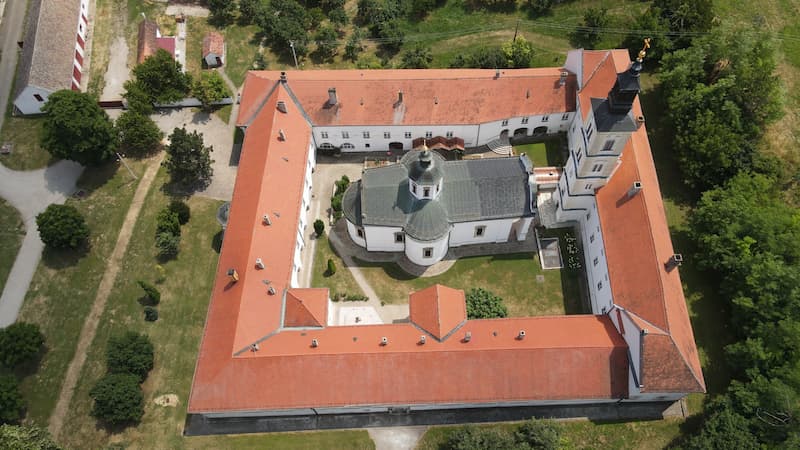
Mala Remeta
The convent is dedicated to the holy day of the Shroud of the Mother of God. According to legend, it was founded by King Dragutin Nemanjić. This is an example of the Serbian-Byzantine style of architecture without Baroque influences. Apart from Mala Remeta, there are also convents Petkovica, Grgeteg, Jazak, Đipša, Vrdnik, Rakovac, Beočin, and Berkasovo.
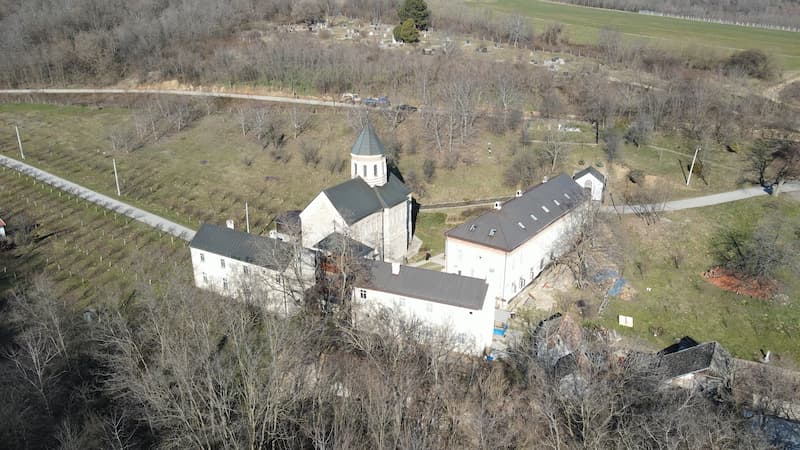
Grgeteg
Legend has it that Grgeteg was founded by Zmaj Ognjeni Vuk for his blind father in the 15th century. The old stone church was replaced by a baroque building in the 18th century. The iconostasis of this monastery was painted by Uroš Predić in 1902. Pilgrims also come to pay homage to the icon of the Three Hands.
Jazak
The Jazak Monastery probably got its name because it is located between two hills (jaz), in a den (jazbina), or this word has Arabic origins. The old Jazak monastery was built by despot Jovan Branković in the late 15th century. During the Great Migration of Serbs, the relics of Tzar Uroš Nejaki were transferred from Nerodimlje to Jazak. Thanks to that, the monastery began to enjoy a great reputation, which contributed to the construction of a new and larger monastery in the 18th century. This is the ‘youngest’ monastery on Fruška Gora, with a particular architecture in which the Baroque intertwines with a slight influence of Islamic architecture. The convent was built with a combination of white stone and red brick, and the bell tower has three floors. There are 58 icons in total. The relics of Emperor Uroš were moved from Jazak several times and were returned there for good in 2001. Here is also a part of the relics of St. Anastasia the Roman, which Prince Lazar received as a gift after visiting the Holy Mountain of Athos. Although the complex of the Jazak convent is quite large, including the dormitories, the sisterhood has only 8 nuns. Many visitors had the opportunity to try their famous brandy, which the nuns make themselves.
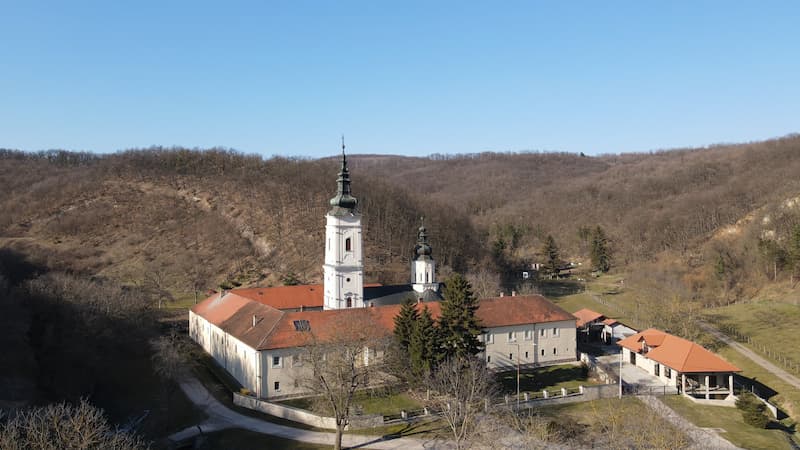
Beočin
Beočin Monastery is located near the village of Beočin. It is dedicated to the Ascension of Christ. It is mentioned for the first time in a Turkish census from the 16th century, but the exact time of its creation is unknown. The most famous holy relic of this monastery is the icon of the Most Holy Mother of God of Beočin, which is believed to be over 500 years old. For those who pray to her with a pure heart, it is believed that she will answer their prayers. In 1815, the relics of St. Stefan the First-Crowned were transferred here from the Fenek monastery. Around the monastery is a park, which was planted by the French more than 150 years ago as a small copy of the Versailles Park.
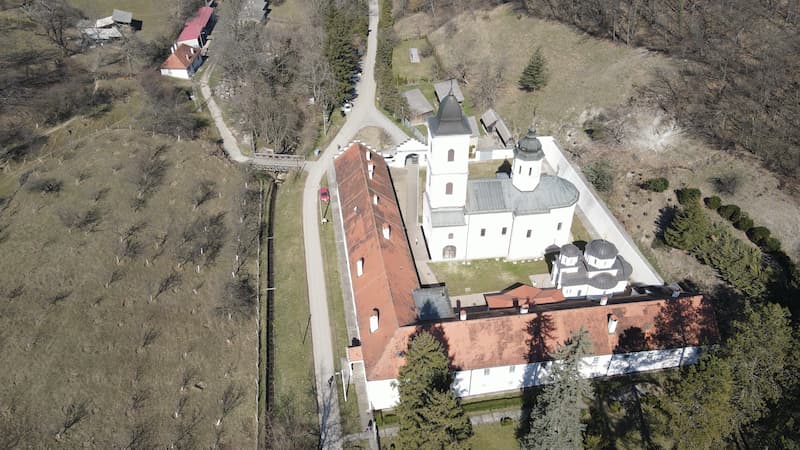
Velika Remeta
The monastery of Velika Remeta was founded by King Dragutin in the late 13th century. It is dedicated to St. Dimitrije. On the monastery property there is a beautifully landscaped garden, a
medicinal water spring Ubavac, and on the left, a small ethnic village with several log cabins and a summer house. There is a spot provided for visitors who want to enjoy nature or barbecue.
Vrdnik
The only Fruška Gora monastery located in a settlement is the Vrdnik Monastery. It was built during the 16th century. The monks of the Ravanica monastery, fleeing from the Turks during the Great Migration of Serbs, settled here. They brought with them the relics of Prince Lazar, which lay here until 1942. Near this monastery are Pavlovci and Borkovac lakes.
Staro Hopovo
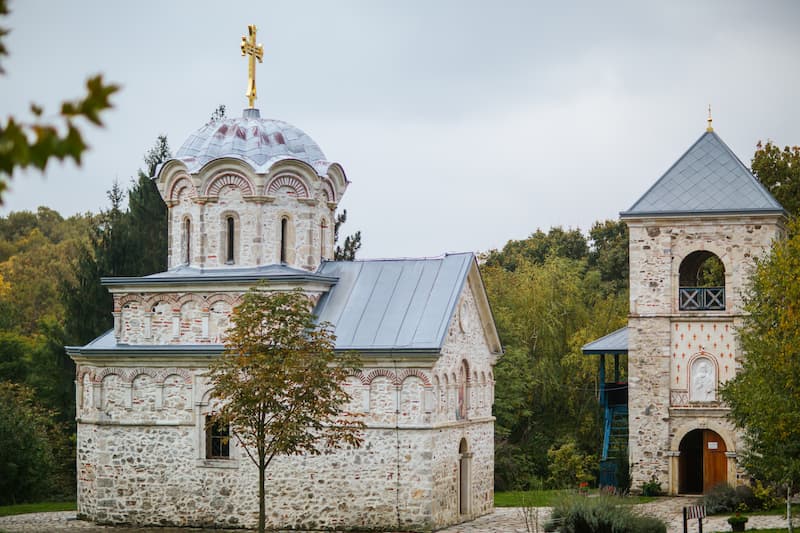
Novo Hopovo
Novo Hopovo Monastery, together with Krušedol, is one of the most important monasteries in Serbia in terms of its architecture, educational role, and cultural, religious and political events. It is located not far from Irig and it’s accessible from the main road. It is believed that it was the first endowment of Đorđe Branković, who founded it in the early 16th century. The relics of the Roman military leader Theodore Tiron are stored in it, and it is the oldest relic kept on the territory of Serbia. The walls of Novo Hopovo were painted by painters from Mount Athos, and they copied entire compositions from their monasteries. The most impressive example is the painting ‘The Massacre of the Children of Bethlehem’, which is kept today in the Vojvodina Museum. Some frescoes were gilded, as was the entire iconostasis, but the gilding eventually deteriorated or was scraped off. For several centuries this was an educational centre where generations of Serbs learned to read and write. In the middle of the 17th century, an unusual and unique institution was created around the monastery – the Fiddlers’ School, mockingly called the ‘academy for the blind’. Dimitrije Obradović became a monk in this monastery and was named Dositej.
Fruška Gora was declared a national park in 1960, and since then, its natural beauties, picnic areas, easy hiking trails and sights have attracted an increasing number of tourists. Well-known Fruška Gora picnic areas are: Iriški Venac, Stražilovo, Andrevlje, Borkovac, Popovica…. There are 16 lakes and several caves here. We should not forget the wineries, where you can try some of the best local wines, Ausbruch, Bermet, and others. All this, along with the obligatory tour of one of the monasteries, makes Fruška Gora an increasingly interesting destination, which is also very photogenic. The Fruška Gora Marathon trail passes next to the monasteries Grgeteg, Novo Hopovo and Jazak.
One legend says that when God created the world, people from Srem slept. So, God divided all the land before they woke up. After they apologised to God, he decided to give them a part of paradise, the area between the Danube and the Sava, with Fruška Gora.
Author: MSc Ljiljana Dragosavljević Savin, Historian
Photo: Marko Pudić; Drone operator: Zoran Ivezić (Media Team)







